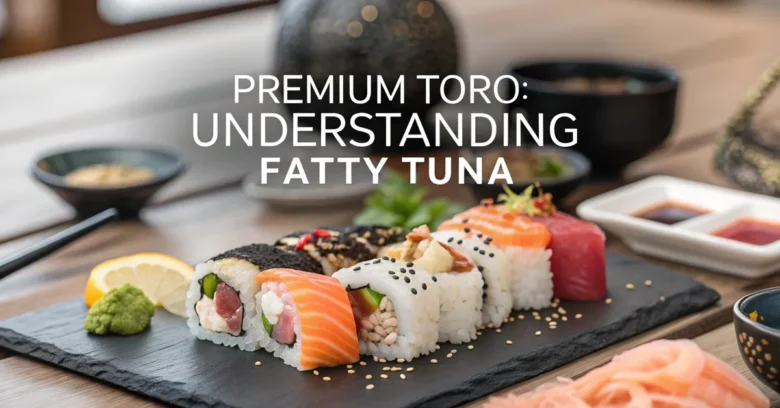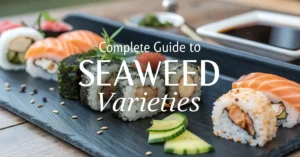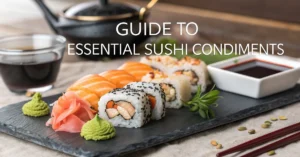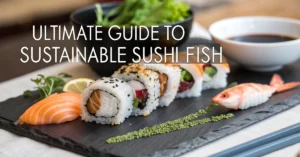Imagine savoring a piece of sushi that simply melts in your mouth, its richness coating your tongue with pure delight. That sensation often comes from toro, or fatty tuna, a coveted delicacy in the world of sushi. But what is fatty tuna exactly, and why is it so prized? What factors affect its quality, and how can you, as a discerning sushi lover, ensure you’re experiencing the very best? This article will explore the world of fatty tuna, from its origins and flavor profile to its selection and sustainability.
Premium Toro: Understanding Fatty Tuna
Fatty tuna, often referred to as “toro,” is the cut of tuna that comes from the belly of the fish. Bluefin tuna is the most prized species for toro, though other tuna species like bigeye can also yield delicious fatty cuts.
What Makes Toro Special?
What sets toro apart from other cuts of tuna? It’s the high fat content, which creates its signature melt-in-your-mouth texture and rich, buttery flavor. This fat isn’t just any fat; it’s packed with omega-3 fatty acids, contributing to its smooth, luxurious mouthfeel.
The location of the cut on the tuna determines the specific type of toro:
- Otoro: This is the fattiest cut, taken from the very front of the belly, closest to the head. Otoro has the most marbling and the richest flavor.
- Chutoro: This cut comes from the middle of the belly and along the back of the tuna. It is a bit leaner than otoro but still offers a delightful balance of fat and flavor.
A Deep Dive Into Flavor
Fatty tuna’s flavor is complex and nuanced. It’s more than just “fatty.” A high-quality piece of toro will offer:
- Richness: The high fat content contributes to a deep, satisfying richness that coats the palate.
- Sweetness: Many describe a subtle sweetness that emerges as the fat melts.
- Umami: The savory, meaty flavor characteristic of tuna is amplified in toro.
- Clean Finish: Despite its richness, good toro should have a clean, refreshing finish, leaving you wanting more.
Grades of Toro: Quality Matters
Not all toro is created equal. Several factors influence the quality of fatty tuna, and grading systems help to classify it. Here are some key factors affecting quality:
- Fat Content: Higher fat content generally equates to a richer flavor and more desirable texture.
- Color: The color of the toro is a visual indicator of quality. A vibrant, pinkish-red color is ideal.
- Marbling: Just like with beef, marbling – the distribution of fat within the muscle – is a sign of quality. Fine, even marbling is preferred.
- Texture: The texture should be smooth, almost creamy, and melt easily in the mouth.
Bluefin Tuna: The King of Toro
While other tuna species can yield fatty cuts, bluefin tuna (Thunnus orientalis) is universally recognized as the pinnacle of toro. Bluefin tuna are prized for their size, fat content, and rich flavor. Within bluefin, several subtypes exist:
- Pacific Bluefin: Found in the Pacific Ocean, this species is known for its firm texture and balanced flavor.
- Atlantic Bluefin: Found in the Atlantic Ocean, this species is often considered the most desirable, boasting high fat content and intensely rich flavor.
- Southern Bluefin: Found in the Southern Hemisphere, this species is prized for its clean flavor and delicate texture.
Finding the Best Fatty Tuna
Now that we’ve covered the basics of fatty tuna, let’s dive into how you can ensure you are getting the highest quality toro when enjoying sushi.
Factors to Consider When Choosing
When selecting fatty tuna, keep the following in mind:
- Source: Ask your sushi chef or fishmonger about the source of the tuna. Knowing the origin can provide clues about its quality and sustainability.
- Appearance: Look for a vibrant color, fine marbling, and a smooth, glossy surface. Avoid toro that appears dull, dry, or discolored.
- Smell: Fresh toro should have a clean, sea-like scent. Avoid anything that smells fishy or ammonia-like.
- Reputation: Choose sushi restaurants or fishmongers with a reputation for quality and freshness. Read online reviews and ask for recommendations.
Understanding the Price
Toro is one of the most expensive cuts of tuna, and prices can vary depending on the grade, source, and season. Be wary of extremely low prices, as they may indicate lower quality or unsustainable fishing practices. Remember the saying, if it’s too good to be true, it usually is!
How to Best Enjoy Toro
Toro is best enjoyed fresh, at room temperature, and with minimal enhancements. Simple preparations allow the natural flavor and texture to shine:
- Nigiri: Thinly sliced toro served atop a bed of vinegared rice.
- Sashimi: Slices of toro served on their own, often with soy sauce and wasabi.
- Donburi: Toro served atop a bowl of rice, often with other toppings.
Enhancing the Experience
When enjoying toro, consider the following to elevate your experience:
- Soy Sauce: Use high-quality, naturally brewed soy sauce.
- Wasabi: Freshly grated wasabi provides a pleasant kick and complements the richness of the tuna.
- Ginger: Thinly sliced ginger acts as a palate cleanser between bites.
- Sake: A dry, crisp sake pairs well with the richness of toro.
The Sustainability of Fatty Tuna
The popularity of toro has placed immense pressure on tuna populations, particularly bluefin tuna. It’s crucial to be aware of the sustainability issues surrounding fatty tuna and make informed choices.
Overfishing and Its Impact
Overfishing has decimated bluefin tuna populations in many parts of the world. Unsustainable fishing practices can also damage marine ecosystems and harm other species.
Responsible Choices
Here are some ways to enjoy fatty tuna more responsibly:
- Choose Sustainable Sources: Look for tuna that has been certified by organizations like the Marine Stewardship Council (MSC) or the Aquaculture Stewardship Council (ASC).
- Ask Questions: Inquire about the sourcing practices of your sushi restaurant or fishmonger.
- Consider Alternatives: Explore other types of sushi that are more sustainable, such as farmed salmon or yellowtail.
- Eat Less Frequently: Reduce your overall consumption of toro to help reduce demand and give tuna populations a chance to recover.
Initiatives for Conservation
Many organizations are working to promote sustainable tuna fishing practices and conserve bluefin tuna populations. Support these efforts by:
- Donating to Conservation Groups: Organizations like the World Wildlife Fund (WWF) and The Nature Conservancy are working to protect tuna populations and promote sustainable fishing.
- Educating Yourself and Others: Learn more about the challenges facing tuna populations and share your knowledge with friends and family.
- Supporting Sustainable Businesses: Patronize restaurants and fishmongers committed to sustainable seafood practices.
The Art of Preparing Toro
The preparation of toro, from the moment it’s harvested to the moment it’s served, is an art form that demands precision, respect, and a deep understanding of the fish.
Sourcing and Handling
The journey of toro begins with the careful selection and harvesting of tuna. Sustainable fishing practices are crucial, as is minimizing stress to the fish during capture to maintain the quality of the meat.
Cutting Techniques
The way toro is cut can significantly affect its texture and flavor. Skilled sushi chefs use specialized knives and techniques to slice toro thinly and evenly, ensuring a melt-in-your-mouth experience.
Aging and Curing
Some sushi chefs employ aging and curing techniques to enhance the flavor and texture of toro. These methods can involve dry-aging, marinating, or other processes that break down proteins and fats, resulting in a more complex and nuanced flavor profile.
The Chef’s Touch
Ultimately, the quality of your toro experience depends on the skill and artistry of the sushi chef. A talented chef will understand how to select, prepare, and present toro in a way that maximizes its flavor and texture.
Beyond the Plate: Cultural Significance
Toro is more than just a delicious food; it’s a cultural icon in Japan and around the world. Its history, symbolism, and social significance add another layer to the enjoyment of this prized delicacy.
History and Tradition
Tuna has been a part of the Japanese diet for centuries, but toro only became widely popular in the 20th century. The development of refrigeration and transportation technologies made it possible to access and distribute fresh toro more widely, leading to its rise in popularity.
Symbolism and Status
In Japan, toro is often associated with luxury, status, and celebration. It’s a common sight at special occasions like weddings, anniversaries, and business dinners.
Globalization
The popularity of sushi has spread around the world, and with it, the demand for toro. This globalization has created both opportunities and challenges, including the need to ensure sustainable sourcing and equitable distribution.
Common Myths About Fatty Tuna
As with any prized ingredient, several myths and misconceptions surround fatty tuna. Let’s debunk some of the most common ones:
- Myth: All Toro is the Same: As discussed earlier, toro comes in different grades (otoro and chutoro), and the quality can vary depending on the source, season, and preparation.
- Myth: The Fattier, The Better: While fat content is important, it’s not the only factor. The flavor, texture, and overall balance of the toro are equally important.
- Myth: You Should Always Dip Toro in Soy Sauce: While soy sauce is a common accompaniment, some purists believe that high-quality toro is best enjoyed without it, allowing the natural flavor to shine through.
- Myth: Frozen Tuna is Inferior: Flash-freezing technology has improved dramatically in recent years, and properly frozen tuna can retain its flavor and texture remarkably well.
- Myth: Toro is Always Unsustainable: While many tuna fisheries are unsustainable, there are also responsible options available. Look for certified sustainable tuna and ask your sushi restaurant about their sourcing practices.
The Future of Fatty Tuna
What does the future hold for fatty tuna? As awareness of sustainability issues grows, expect to see increased emphasis on responsible sourcing, alternative species, and innovative farming techniques.
Sustainable Aquaculture
Aquaculture, or fish farming, is one potential solution to the overfishing of wild tuna populations. Sustainable aquaculture practices can help reduce pressure on wild stocks while still meeting the demand for toro.
Alternative Species
While bluefin tuna is the most prized species for toro, other types of tuna, such as bigeye and yellowfin, can also yield delicious fatty cuts. Exploring these alternatives can help reduce pressure on bluefin populations.
Innovative Technologies
New technologies, such as blockchain and DNA tracking, are being used to improve the traceability and transparency of tuna supply chains, helping consumers make more informed choices.
So, is Fatty Tuna Worth It?
Fatty tuna, with its melt-in-your-mouth texture, rich flavor, and cultural significance, can be a truly exceptional culinary experience. By understanding the factors that influence quality, making responsible choices, and appreciating the art of its preparation, you can savor the very best that this delicacy has to offer while supporting a more sustainable future for our oceans. The key is to be an informed and discerning consumer. Ask questions, seek out reputable sources, and always prioritize sustainability. When you do, the experience will be all the more rewarding.



